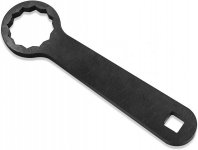ButterSmooth
New member
The axle nut on my RT is easily reached with a combination wrench. With a socket, not so much...
The muffler makes access difficult on the nut side. I experienced this with my last Indian and Harley Davidson. On the Harley I did a test by torquing from the axle end, and then checking the torque on the nut end. They were the same. I blindly transferred the technique to the Indian. Now we come to the RT. I wonder if anyone has any KNOWLEDGE (not speculation or SWAG) about a difference in tightening the axle this way. Is a different number required? Sure makes life easier...
The muffler makes access difficult on the nut side. I experienced this with my last Indian and Harley Davidson. On the Harley I did a test by torquing from the axle end, and then checking the torque on the nut end. They were the same. I blindly transferred the technique to the Indian. Now we come to the RT. I wonder if anyone has any KNOWLEDGE (not speculation or SWAG) about a difference in tightening the axle this way. Is a different number required? Sure makes life easier...

